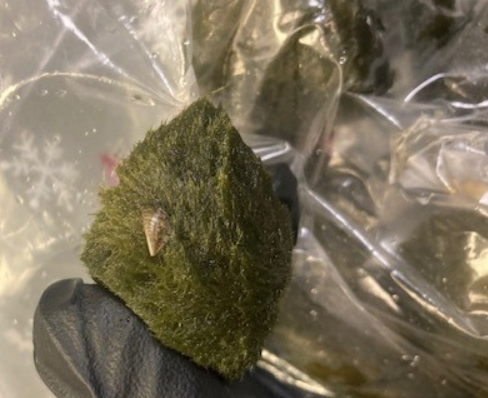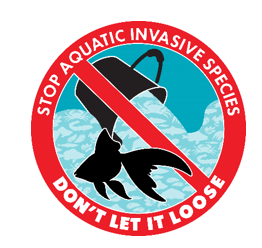Information on the disposal of moss balls
Zebra mussels have been found in many kinds of moss ball products, which are used for aquaria or water gardens. Some moss balls that contained zebra mussels were found in B.C. These moss balls, which are often sold as “Marimo Moss Balls”, are species of green algae typically used to improve water quality in aquaria. Moss balls can also be purchased online.

(Above: zebra mussel found on moss ball.)
Please follow the steps below to deal with moss balls and aquarium water. If you find any zebra mussels while dealing with the moss balls, please report your findings to the RAPP line: 1-877-952-RAPP (7277).
Additional information will be posted in the future.
Step 1: Treat the moss balls
- Place into a plastic bag, zip closed and freeze (preferably in a deep freezer) for at least 24 hours
Or
- Place in boiling water for at least 1 minute and then let cool
Step 2: Dispose of moss balls
- Place the moss ball and the package it came in into a sealed plastic bag and dispose in your household garbage
To prevent zebra mussels from getting into our water bodies, do not dispose of the moss ball or any aquarium or water-garden contents (for example substrate, plants, et cetera), by:
- Flushing down the toilet
- Putting down drain, or
- Putting in a compost
After moss balls have been removed from an aquarium, do not dispose of untreated water down the drain or into any residential water system or waterway. Instead, take the additional steps below.
Step 3: Treat aquarium contents and water
The protocol described below must be followed exactly to be effective in decontaminating tanks and systems that may be contaminated with invasive mussels from infested moss balls. Choose the protocol that is most practical in your situation – both, if followed correctly, will kill all zebra mussels (veligers and adult).
Protocol 1: Heat treatment for tanks without plants or animals
This protocol may harm or injure live plants and animals, and should only be used in tanks or containers that do not contain live plants or animals. Live organisms can be removed, but make sure that any equipment (such as nets) used to remove fish or plants from the contaminated tank or container is properly decontaminated immediately after use by putting it in hot water. See the table below.
Treatment instructions:
- It is important to keep the temperature the same throughout the treatment to eliminate all of the zebra mussels.
- Raise and keep the temperature of tank water according to the table below. Make sure the water is mixing throughout the entire system.
|
Minimum temperature |
Minimum time |
|---|---|
|
40˚C |
30 min |
|
45˚C |
15 min |
|
50˚C |
5 min |
Following the thermal treatment, water can be disposed of through your wastewater system.
Protocol 2: Potassium Chloride (KCl) treatment for tanks WITH plants or animals
This protocol can be used when plants and animals cannot be removed, or if protocol 1 is not possible. It is considered safe for most fish with fins and plants, but it may not be safe for invertebrates. This protocol requires the use of potassium chloride (KCl), a sodium-free table salt substitute commonly sold at grocery and nutritional stores. The highest available purity of KCl available should be used. “Half-Salt” products cannot be used.
Treatment Instructions:
- The aquarium or system must be kept at the required treatment concentration for at least 14 days.
- Water in the aquarium or system must be maintained at a minimum of 17°C for the duration of the treatment.
- Water changes should be avoided during the 14-day treatment period. If water changes cannot be avoided within the 14-day period, treat the removed water using one of the following methods:
- (A) Protocol 1 above using the Heat Treatment prior to disposal, or if that is not possible,
- (B) Filter and chlorine bleach method prior to disposal
- i. Filter the removed water with a filter size up to 50 microns
- ii. Treat the filtered water with 25 ml/L of chlorine bleach (minimum 5% Sodium Hypochlorite) for 15 minutes.
- iii. If a disposable filter is used, treat that filter with a solution of KCl for 14 days and dispose of it in the garbage
- Water evaporating from the tank will not remove KCl from the system. Water can be added as long as the total volume of water in the tank does not exceed the initial volume when treatment began. This will ensure the correct dosage is maintained throughout the 14 days.
- To ensure consistent treatment conditions, all added water must be prepared using water from an uncontaminated source, warmed to a minimum of 17°C and pre-treated by dissolving the required amount of KCl based on the volume of water needed for the water change, as indicated in the table provided.
- Following this 14-day treatment, water can be disposed of through your wastewater system.
Dosage:
- Remove a small volume of water (approximately 1 litre) from your aquarium or system and place this water into a separate container.
- Determine the volume of water in your aquarium or system and the corresponding amount of KCl required to achieve the required treatment concentration using the table provided below.
- Add the required amount of KCl to this separate container of water and mix thoroughly.
- Once the KCl has dissolved in the container, pour this mixture back into your aquarium or system. Ensure the water circulates throughout the entire system.
|
Volume of water in Aquarium |
Amount of KCl required* (100% solubility) |
||
|---|---|---|---|
|
US gal |
Litres |
Teaspoons (US) |
Grams |
|
1 |
3.8 |
¼ |
1 |
|
10 |
38 |
2 |
8 |
|
20 |
76 |
3 ¾ |
15 |
|
55 |
208 |
10 |
40 |
|
75 |
284 |
13 ½ |
54 |
|
90 |
341 |
16 ½ |
65 |
|
125 |
473 |
22 ½ |
90 |
*Dosages shown in this table are based on a known, lethal concentration of 100ppm KCl to Dreissenid mussels, over an exposure period of 14 days and within the expected temperature range of home and retail aquariums (above 17 º C). Measurements in this table have been rounded up to make measuring easier.

